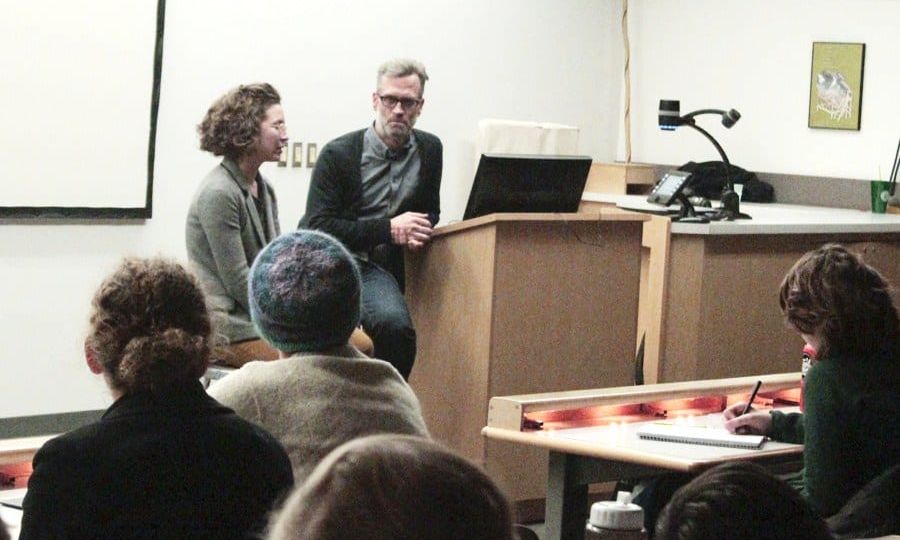
On Feb. 18, the St. Olaf Art Department kicked off its annual Arnold Flaten Memorial Lecture Series. Patrick Kelley ’91 and Mary Reid Kelley ’01, two Ole graduates now married and working together as professional artists, returned to the Hill for the first lecture in the 2014 series. A long-standing tradition beginning in 1981, the series recruits nationally recognized artists to discuss their work, artistic processes and experience making a living in the field. This year, eight individuals representing different artistic mediums will speak over seven sequential Monday nights at 7 p.m. in Dittmann Center 305.
Kelley and Reid Kelley, video and 2-D artists, came back to the Hill with a goal of inspiring young artists to think about their careers beyond St. Olaf. Both artists have graduate degrees, teaching credits and extensive show experience. For art students anxious about future career prospects, success stories like theirs are sure to be a comfort.
Professor of Art and Associate Dean of Fine Arts Mary Greip introduced the pair as “the perfect advertisement for the liberal arts” due to their diverse backgrounds, interests, skillsets and artistic abilities. While their work is, perhaps, a bit too risqué to grace the cover of a St. Olaf brochure, the comment perfectly summarizes the artistic processes that these two artists employ in their work.
During their lecture, the pair discussed their artistic process in the development of four of their recent films, elaborating on each stage from idea to finished product. Their interests in language, history, poetry and political and sexual commentary come through in their black and white multi-media films, offering students an example of the cross-disciplinary approach they both bring to their work. They encouraged students to bring their own experiences and interests – any and all of them – into their own work.
One such example of interest integration is the dialogue the artists use in their films: rhyming narrative that takes its cue from early twentieth-century art and literature that was popularized for critiquing wartime institutions.
According to Reid Kelley, “That cultural response really happened through poetry,” and if all of those “normal people” could take up poetry in order to have a voice amidst the conflict, she could try it too. This newfound interest in poetry transitioned into a love of puns and alliteration, a fascination evident in the titles of two of her films: “Sadie the Saddest Sadist” and “The Syphilis of Sisyphus.”
While Kelley’s and Reid Kelley’s areas of expertise vary greatly from one another, it is their collaboration that offers an entirely new form of artistic expression.
Rather than focusing purely on new media, the pair utilizes 3-D modeling to allow their “videos [to] become collages.” Reid Kelley’s background in physical media like painting and drawing shines through via the integration of motifs like a cobblestone road, paintings on the wall and patterns on the furniture. These components contain physical textures within the computer-generated format, allowing the Kelleys’ videos to become multi-dimensional.
Kelley noted that he particularly enjoys the freedom these digital sets intrinsically allow. With a computerized rather than physical set, the pair has the opportunity to continue “working and constructing and layering,” constantly adding depth to their work.
The two artists’ calculated fun shines through in every film. Black and white face paint, parodied characters, punny humor and clever rhymes highlight the couple’s love of craft. When combined with darker themes of war, sexuality and political tension, the juxtaposition created in each film parallels their artistic process of combining physical and digital media with performance and language arts. Shown in galleries on looping tapes, the Kelleys’ work can be watched over and over.
“Our work always has something further to give you,” Reid Kelley said. This diversity in both theme and process exemplified the couple’s vital advice for the students in attendance regarding the advantages of multilayered thought.
Several weeks remain in the Flaten Lecture series, and several more artists have yet to come challenge our perception of art, our methods of thinking and our processes of creating. On Tuesday, Feb. 25, Scott Stulen, a multimedia artist exploring “the fleeting nature of memory,” continued the series. Other upcoming lecturers include large-scale sculptor and installation artist Pritika Chowdry March 3, photographer Andrew Moore March 10, art critic Mary Abbe March 17, ceramicist Maren Kloppmann March 31 and behavior and conceptual artist Marcus Young April 7. Each lecture will be different, but the series promises to excel in a way any eager, multi-talented liberal arts student is sure to appreciate.
nelsons@stolaf.edu

